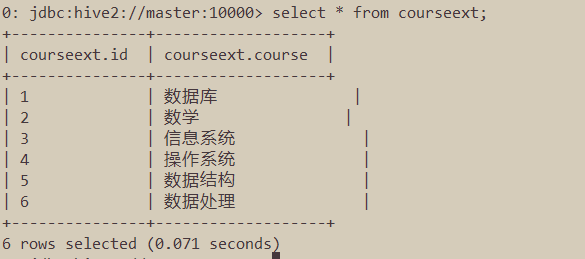Hive表分为内部表和外部表
Hive默认建立的表是内部表,内部表create之后,然后load加载hdfs上的数据,会移动物理数据到Hive的数据仓库默认目录(/user/hive/warehouse/xx.db/)下。
内部表drop之后,元数据和物理数据都会删除。
外部表在导入hdfs的数据后,数据并没有移动到自己的数据仓库目录下,也就是说外部表中的数据并不是由它自己来管理的!
外部表drop掉之后,元数据删掉了,但是实际物理数据还存在原位置。
以下是示例:
在本地建立vim一个course.txt文件
上传到hdfs文件系统上inner目录下和ext目录下
[root@master hiveTest]# hdfs dfs -put ./course.txt /inner
[root@master hiveTest]# hdfs dfs -put ./course.txt /ext
hive创建内部表
hive> create table db_hive.courseInner(id int,course string) row format delimited fields terminated by ',';
加载hdfs的inner目录下的course.txt到内部表
hive> load data inpath '/inner/course.txt' into table db_hive.courseInner;
此时,inner目录下的文件已经被移到了hive数据仓库的目录/user/hive/warehouse/db_hive.db/下。
[root@master hiveTest]# hdfs dfs -ls /user/hive/warehouse/db_hive.db
然后执行drop table db_hive.courseInner,则该目录及目录下的数据被删除。
Hive创建外部表,关键字external,location指定数据存放的文件夹。
hive> create external table courseext(id int,course string) row format delimited fields terminated by ',' location '/external'
此时courseex外部t表就已经链接到这个物理数据,不需要执行load语句了。
执行查询语句,可以查到外部表的数据。

外部表执行drop table courseext,则该表的元数据被删除,但物理数据依然存在,可以通过命令验证。
[root@master hiveTest]# hdfs dfs -ls /external
使用场景:
每天收集到的网站数据,需要做大量的统计数据分析,所以在数据源上可以使用外部表进行存储,方便数据的共享。
在做统计分析时候用到的中间表,结果表可以使用内部表,因为这些数据不需要共享,使用内部表更为合适。